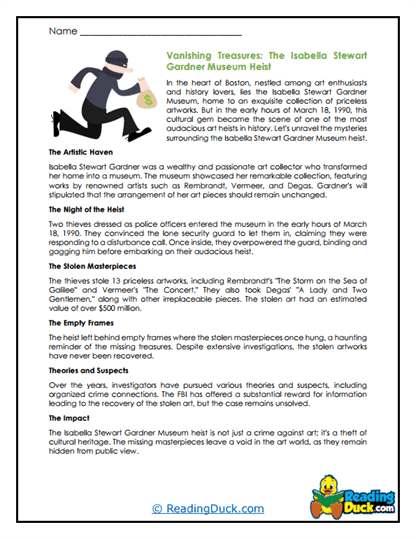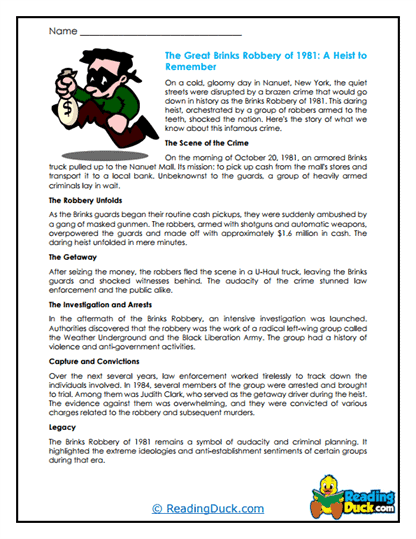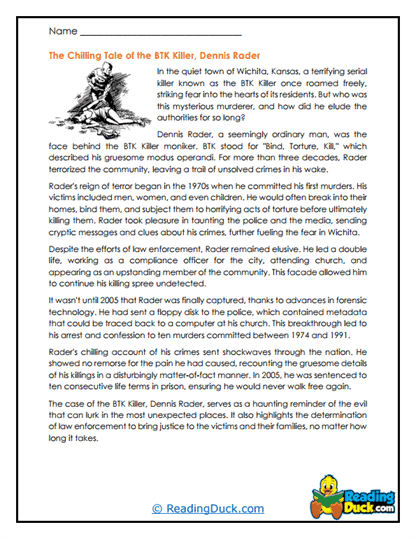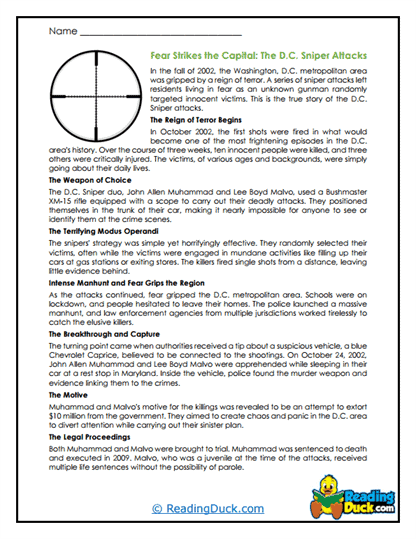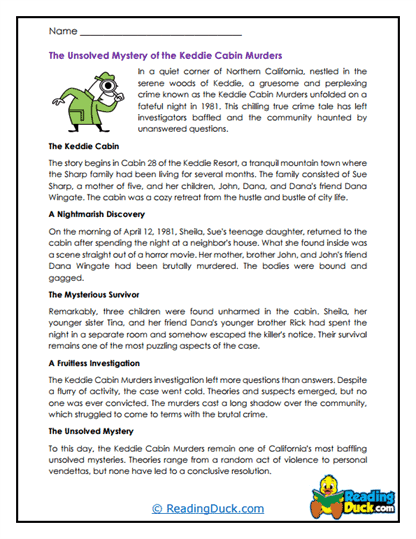True Crime Worksheets
About Our True Crime Worksheets
Our True Crime Worksheets provide students with an engaging and thought-provoking way to explore the nonfiction genre of true crime. Each worksheet set includes a true crime reading passage that delves into real-life cases, offering a narrative that captures the details of criminal investigations, legal processes, and societal impacts. Accompanied by multiple-choice questions, short answer prompts, and open-ended response questions, these worksheets help students deepen their understanding of the true crime genre while developing critical analytical skills.
Available in PDF format for easy viewing, downloading, and printing, these worksheets are ideal for both classroom use and independent study. Each set includes a downloadable answer key, making it convenient for educators to assess students' comprehension and engagement with the material. Whether students are learning about historical cases or exploring modern criminal investigations, these worksheets foster a deeper appreciation for the complexities of true crime storytelling.
Understanding the True Crime Genre
True crime is a nonfiction genre that focuses on real-life crimes and their consequences, often exploring the intricate details of criminal acts, legal proceedings, and the individuals involved. It is a genre that has captivated audiences for centuries, as it combines the factual recounting of events with elements of investigation, psychology, and sometimes even mystery. True crime narratives often delve into not only the criminal acts themselves but also the motives behind them, the societal context in which they occur, and the impact on victims, families, and communities.
Key themes in true crime include:
- Justice and morality: Exploring how crimes challenge societal notions of right and wrong and how the legal system seeks to uphold justice.
- Psychology of crime: Understanding the motives, behaviors, and psychological profiles of criminals.
- Societal impact: Examining how crimes affect communities, shape public perceptions, and lead to changes in law and policy.
- Legal processes: Delving into the intricacies of criminal investigations, trials, and sentencing.
True crime is essential to nonfiction because it provides readers with insight into real-world issues surrounding crime, justice, and human behavior. By engaging with true crime, students can gain a deeper understanding of how laws are enforced, how ethical dilemmas arise in the pursuit of justice, and how society reacts to criminal acts. This genre also opens the door to discussions about mental health, morality, and the challenges of navigating a complex legal system.
The True Crime Worksheets introduce students to a range of real-life cases, from notorious historical crimes to modern-day investigations. These passages provide not only a gripping narrative but also opportunities for students to critically analyze the facts, question motives, and reflect on the broader social implications of crime.
Developing Critical Skills Through True Crime
Our True Crime Worksheets are designed to help students build essential genre-specific skills that are crucial for understanding and analyzing nonfiction texts. True crime requires readers to interpret complex narratives, engage with facts, and critically assess the motives, actions, and consequences of the events being described.
Here’s how these worksheets help students develop key skills:
- Reading comprehension: The multiple-choice questions focus on ensuring that students can identify important details, sequence events, and understand the structure of true crime narratives.
- Critical thinking: Short-answer questions challenge students to analyze the motives behind crimes, assess the effectiveness of investigations, and evaluate the legal outcomes of the cases discussed.
- Creative expression: Open-ended response questions allow students to offer their own interpretations of the cases, encouraging them to think about broader ethical and societal issues while applying the knowledge they’ve gained from the reading.
For example, a worksheet on a case involving a high-profile trial might include questions asking students to consider how media coverage affected public perception of the crime, or to reflect on the ethical responsibilities of the legal system in ensuring a fair trial. These questions push students to think critically about the material while fostering a deeper connection to the content.
Supporting English Language Learners (ELL) with True Crime
Our True Crime Worksheets are a valuable tool for supporting English Language Learners (ELL) as they engage with complex nonfiction texts. The true crime genre often involves legal terminology, criminal jargon, and descriptive narratives that can challenge language learners. However, with the help of structured worksheets, ELL students can enhance both their comprehension and vocabulary while gaining insights into real-world issues.
Here’s how these worksheets support ELL students:
- Vocabulary development: The worksheets introduce essential terminology related to crime, law, and psychology, helping ELL students expand their academic vocabulary and understand genre-specific language in context.
- Reading comprehension support: The multiple-choice and short-answer questions help guide ELL students through the material, breaking down complex narratives into manageable sections that ensure they understand the key facts and ideas presented.
- Expression and reflection: Open-ended questions provide opportunities for ELL students to practice writing responses that require both comprehension and personal reflection, helping them build language fluency and develop critical thinking skills.
With downloadable answer keys, teachers can offer timely feedback to ELL students, helping them improve their language skills while fully engaging with the true crime material.
Building Cross-Disciplinary Connections with True Crime
One of the strengths of the true crime genre is its ability to connect to a wide range of academic subjects, making the True Crime Worksheets an excellent tool for cross-disciplinary learning. The genre touches on topics such as history, psychology, law, and social studies, providing students with a comprehensive understanding of how crime intersects with various aspects of society.
Here are some ways true crime links to other disciplines:
- History: Many true crime cases are rooted in specific historical periods, offering students a chance to explore how historical context influences criminal behavior and societal reactions. For instance, a worksheet on a famous 20th-century criminal case might explore how social norms and legal standards of the time shaped the investigation and trial.
- Psychology: True crime often delves into the psychological aspects of criminal behavior, such as profiling, motives, and mental health. A worksheet might include passages on criminal psychology or behavioral analysis, prompting students to consider the mental states of criminals and how psychological factors impact crime.
- Law and justice: The legal aspects of true crime—trials, investigations, sentencing—are rich areas for exploration. Students can engage with the legal process by analyzing how justice is pursued, the role of evidence in court, and the ethical dilemmas that arise in the pursuit of justice.
By connecting true crime to these disciplines, the True Crime Worksheets provide students with a holistic learning experience, fostering deeper insights into both criminal justice and broader social issues.
Integrating True Crime into Literacy Programs
The True Crime Worksheets are an ideal resource for integrating true crime content into broader literacy programs, helping students improve their nonfiction reading and writing skills while engaging with real-world topics. True crime texts often present detailed narratives that require close reading and analysis, making them perfect for developing critical literacy skills.
Here’s how the worksheets support literacy development:
- Close reading: The multiple-choice questions require students to pay careful attention to the details of the narrative, ensuring they can identify key facts, understand complex events, and follow the sequence of actions.
- Analytical writing: Short-answer and open-ended questions help students practice constructing thoughtful responses based on evidence from the text, fostering their ability to write analytically and support their arguments.
- Discussion and debate: True crime cases often raise ethical and legal questions that can lead to engaging classroom discussions. The worksheets can be used as a foundation for debates or group discussions, allowing students to practice articulating their ideas while listening to the perspectives of others.
Incorporating these worksheets into literacy programs helps students improve their reading comprehension and analytical writing skills, while also encouraging them to engage with real-world issues in a meaningful way.
Encouraging Personal Reflection and Interpretation
True crime is a genre that often prompts readers to reflect on broader issues of morality, justice, and human behavior. Our True Crime Worksheets encourage students to connect the material to their own values, beliefs, and experiences, fostering personal reflection and critical thinking.
Here’s how the worksheets encourage deeper engagement:
- Ethical reflection: Open-ended questions often invite students to consider the ethical dilemmas presented in true crime cases. For example, they might be asked to reflect on whether they believe the punishment fit the crime, or how the legal system handled a particular case.
- Personal interpretation: True crime often leaves room for interpretation, especially when it comes to understanding motives or evaluating the actions of law enforcement. The worksheets encourage students to form their own opinions about the material and think critically about how justice is served.
- Real-world connections: By engaging with real-life crimes, students are prompted to think about how these issues might relate to their own lives and communities, fostering a deeper connection to the content.
For example, a worksheet on a case involving wrongful conviction might prompt students to consider how the criminal justice system can sometimes fail, leading them to reflect on the importance of fairness and accuracy in legal proceedings.
Conclusion
Our True Crime Worksheets provide a unique and engaging way for students to explore the compelling nonfiction genre of true crime. Through a combination of reading comprehension, critical analysis, and creative reflection, these worksheets help students deepen their understanding of crime, justice, and human behavior.
Adaptable for English Language Learners and connected to a variety of academic disciplines, the True Crime Worksheets offer a comprehensive resource for fostering cross-disciplinary skills and engaging students with real-world issues. Whether used as part of a broader literacy program or as a standalone resource, these worksheets provide an invaluable tool for exploring the complexities of crime and justice.
By encouraging personal reflection and ethical inquiry, the worksheets make true crime more than just a captivating genre—it becomes a pathway for students to develop critical thinking skills, form well-reasoned opinions, and gain a deeper appreciation for the real-world implications of crime and justice.
